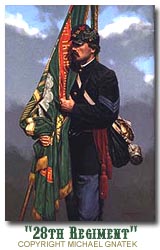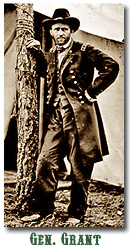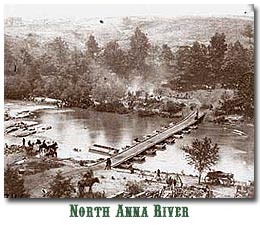1861
| 1862 | 1863 |
1865
Regimental
History: 1864
 ith the
28th Massachusetts in camp for the
winter, Col. Byrnes and four of his officers returned home on February
14 to recruit the regiment back up to strength. Their trip took them to
New Bedford, Lowell and Milford, but they met with their greatest
success in Boston. Encouraged by community leaders, some 326 men
enlisted.
ith the
28th Massachusetts in camp for the
winter, Col. Byrnes and four of his officers returned home on February
14 to recruit the regiment back up to strength. Their trip took them to
New Bedford, Lowell and Milford, but they met with their greatest
success in Boston. Encouraged by community leaders, some 326 men
enlisted.
 The unit accepted 288 of these new
recruits between February and May. This infusion of soldiers was enough
to bring the regiment back to a respectable 504 men of all ranks for
the start of the spring campaign. Recruiting was bolstered by the
attraction of high enlistment bounties: huge sums of $600 or more that
far exceeded a year's salary for an average worker.
The unit accepted 288 of these new
recruits between February and May. This infusion of soldiers was enough
to bring the regiment back to a respectable 504 men of all ranks for
the start of the spring campaign. Recruiting was bolstered by the
attraction of high enlistment bounties: huge sums of $600 or more that
far exceeded a year's salary for an average worker.
These late-war recruits brought an entirely
new character to the regiment. Most were non-Irish and many were from
outside of Massachusetts. They came from many states and countries.
Almost 90 of them were Canadians. While a number of these new recruits
deserted at the first opportunity, taking the money and running, many
were good men who would contribute much to uphold the honorable
traditions established by those who served before them.
Despite the influx of these recruits, who
now far outnumbered the old veterans, the 28th Massachusetts retained
its distinctive Irish martial spirit, exemplified in a speech that Col.
Byrnes gave upon the occasion of receiving a new green regimental flag
from the citizens of Boston at the Parker House Hotel in May:
"I can promise you no more, than to assure
you that (this flag) will be a fresh incentive to the brave men who are
periling their lives in defense of that flag which typifies Union and
liberty, and beneath which the shamrock has ever bloomed. In a few
days, this flag will throw its emerald folds to the breeze, and the
smoke of battle will encircle it; its freshness and beauty may be
tarnished, but while there is an Irish arm to strike in its defense,
its honor shall never, never be sullied or impaired. I can only point
to the past history of my regiment to vouch for the future. Neither
Massachusetts nor the historic fame of our race need blush for such a
regiment."
During this time, Byrnes also used his
influence in the Governor's office to secure appointments for four
vacant lieutenancies. Once again, the positions were filled by men who
had not previously served in the 28th Massachusetts, even though there
were many deserving non-commissioned officers who had performed
faithfully in the ranks through more than two years of hard service.
 Understandably, this left many of the old
veterans bitter, especially since two of the new appointees, Henry M.
Binney and Patrick Black, were rumored to have initially signed up as
enlisted men so they could collect bounty payments that commissioned
officers were not legally entitled to receive. But even after an
investigation by the Governor's office determined that neither man had
ever been paid any bounty money, the hard feelings remained. Sgt.
Peter Welsh of Co. K wrote in a letter
home: "It is generally believed here that he (Byrnes) has been selling
commissions in Boston, some of them are men who were dismissed from the
service in other regiments."
Understandably, this left many of the old
veterans bitter, especially since two of the new appointees, Henry M.
Binney and Patrick Black, were rumored to have initially signed up as
enlisted men so they could collect bounty payments that commissioned
officers were not legally entitled to receive. But even after an
investigation by the Governor's office determined that neither man had
ever been paid any bounty money, the hard feelings remained. Sgt.
Peter Welsh of Co. K wrote in a letter
home: "It is generally believed here that he (Byrnes) has been selling
commissions in Boston, some of them are men who were dismissed from the
service in other regiments."
With Byrnes still absent, Lt. Col.
Cartwright once again assumed command of the 28th Massachusetts, which
on May 3 broke winter camp and marched from Stevensburg, Virginia. Two
days later, the regiment was heavily engaged in the Battle of the
Wilderness.
Participating in the attack that the 2nd
Corps launched through dense woods and undergrowth along the Brock
Road, the 28th surged forward, was pushed back, and then tenaciously
defended its entrenchments until ammunition ran out and the order came
to withdraw. Capts. James McIntyre and Charles V. Smith were mortally
wounded during the fight, and Lt. Col. Cartwright received a wound
severe enough that it would eventually force his resignation from the
regiment at the end of 1864.
Now under the command of Maj. Andrew Lawler,
the 28th Massachusetts spent the morning of May 6 strengthening its
breastworks with dry logs, brush, and fence rails. That afternoon, Lee
launched a counterattack, and a swarm of Confederates emerged without
warning from a dense thicket fifty yards in front of the Irish Brigade.
The rebels advanced as far as the federal works, but between volley
after volley of hot musket fire from the Irishmen and the eruption of a
fire in the breastworks between the blue and gray troops, Lee's attack
was repulsed and Confederate losses were severe.
 The men of the 28th Massachusetts spent
the next day on the Brock Road line, trading shots with Confederate
pickets in the woods. They were ordered to abandon the position that
night, marching under the cover of darkness to arrive at Todd's Tavern
early on May 8. During the ferocious fighting that characterized the
Battle of the Wilderness, the regiment lost 119 men killed and wounded.
The following day, the 28th suffered another 12 casualties while
entrenching under artillery bombardment after crossing the Po River.
The men of the 28th Massachusetts spent
the next day on the Brock Road line, trading shots with Confederate
pickets in the woods. They were ordered to abandon the position that
night, marching under the cover of darkness to arrive at Todd's Tavern
early on May 8. During the ferocious fighting that characterized the
Battle of the Wilderness, the regiment lost 119 men killed and wounded.
The following day, the 28th suffered another 12 casualties while
entrenching under artillery bombardment after crossing the Po River.
Although these initial movements of what
would become Gen. Grant’s Overland Campaign brought heavy
losses and did little to dislodge Confederate forces from their
defensive positions protecting Richmond to the south, the Union
commander was determined to press on. He was not going to hesitate or
pull back to rest and regroup as many of his predecessors had done.
Instead, Grant kept relentless pressure on Lee's Army of Northern
Virginia, knowing the North could sustain heavy losses while the South
could not. For the veteran units of the hard-fighting 2nd Corps, this
meant non-stop action, but they were cheered by the prospects of
ultimate victory.
The armies clashed again at Spotsylvania
Courthouse, where on May 11, Grant decided to assault the rebel works
at a salient known as the "Mule Shoe," hoping to outflank the
Confederate lines. The Irish Brigade marched through dense woods and
pouring rain for most of the previous night to join along with two 2nd
Corps divisions in the line of battle at daybreak. As the first streaks
of sunlight appeared, the 28th Massachusetts joined in the gallant
charge on the Confederate entrenchments.
With bayonets fixed and rifles uncapped, the
Irishmen ran across an open field and tore into the enemy. After a
brief hand-to-hand struggle, they shared in the honor of capturing some
4,000 rebels and numerous pieces of their artillery. Capt. James
Fleming reported that one 28th Massachusetts soldier single-handedly
captured a Confederate general in his tent. Unable to advance beyond the reserve
line of works, the Irish stubbornly held on to the captured
entrenchments for the rest of the day, turning back repeated rebel
attempts to retake them.
Unable to advance beyond the reserve
line of works, the Irish stubbornly held on to the captured
entrenchments for the rest of the day, turning back repeated rebel
attempts to retake them.
Mid battle, a drenching rain began to fall
and both armies sought to gain advantage from opposing sides of the
trenches. Men fired into each other's faces across the deadly space,
shot through crevices in a log wall, and furiously sought to bayonet
one another over the top of the works. The dead and dying were piled on
either side of the barrier as artillery shells rained down from above.
Finally, at around midnight, Confederates forces withdrew, leaving the
bloody ground in the hands of the victorious Union troops. The 28th
Massachusetts had lost another 62 men.
On May 14, the regiment suffered two more
casualties on picket duty. For the next two days, the 28th remained in
its trenches under almost constant fire from Confederates who were also
entrenched only a short distance away. Then, on the night of May 17,
the Irish Brigade formed in column behind its works and prepared for
another attack at dawn.
In the assault that followed on the morning
of May 18, the 28th Massachusetts charged over the same ground it had
won during the fight at the Mule Shoe, while Confederate batteries
rained shells down on the advancing federal troops. With Maj. Lawler at
the head of the column, the men of the 28th successfully swarmed over
the first line of rebel earthworks, but the Union attack was repulsed
at other points along the line, and the Irish Brigade was forced to dig
in and face Confederate counterattacks from its front and left. In
spite of enfilading grape and cannister fire from rebel artillery, the
28th and its brother Irish regiments held fast, only to be ordered back
to their original lines.
Among the 42 men from the 28th Massachusetts
who fell during this second assault at Spotsylvania was Maj. Lawler,
who died before the day was over. He was enormously popular with the
men of the regiment, who took his death hard. One soldier wrote that
Lawler was "beloved by all, possessed of an ardent, hopeful temperament
which no hardship, however severe, could dampen... he was the life of a
bivouac, while his rollicking humor and endless jokes often shortened
the weary march." Also mortally wounded were two other experienced
officers: Capts. William F. Cochrane and James Magner.
 The 28th Massachusetts then moved to the
left along with the rest of the Army of the Potomac as Grant continued
applying pressure at the flanks of Lee's army. On May 20, Col. Byrnes
returned to the regiment and was almost immediately placed in command
of the Irish Brigade, since he was senior to Smyth. Byrnes was
undoubtedly dismayed to learn that the 28th had by then been reduced to
315 men.
The 28th Massachusetts then moved to the
left along with the rest of the Army of the Potomac as Grant continued
applying pressure at the flanks of Lee's army. On May 20, Col. Byrnes
returned to the regiment and was almost immediately placed in command
of the Irish Brigade, since he was senior to Smyth. Byrnes was
undoubtedly dismayed to learn that the 28th had by then been reduced to
315 men.
After two days of much-needed rest near
Anderson's Mill, the 28th Massachusetts moved at night on May 20 and 21
to Milford Station, making it to the North Anna River by May 23, and
crossing the next day. Once on the other side, the Irishmen acted first
as guards for the army's wagon train, then were held in reserve during
the 2nd Corps attacks along the North Anna. They spent May 25 and 26
destroying track and a bridge along the Richmond-Fredericksburg
railroad line.
The regiment re-crossed the North Anna on
May 27 and reached Tolapotomy Creek the following day, losing 13 men on
the picket line and dozens more to the effects of heat exhaustion. The
weather had turned very dry, the marching kicked up clouds of dust,
water was scarce, and food was also in short supply. Making matters
worse was an all-night forced march that started late in the day and
continued through noon on May 28.
After a much-needed day's rest, the Irishmen
were ordered to make an uneventful reconnaissance along the Totopotomoy
on May 29. Then, for the next two days, they remained in support
positions behind the main Union lines, undoubtedly grateful to be held
out of the worst of Grant's assaults on entrenched Confederate
positions. The 28th Massachusetts was called to the skirmish line on
May 31, pushing up close to the enemy breastworks and suffering a few
casualties in scattered fighting.
Continued
>

